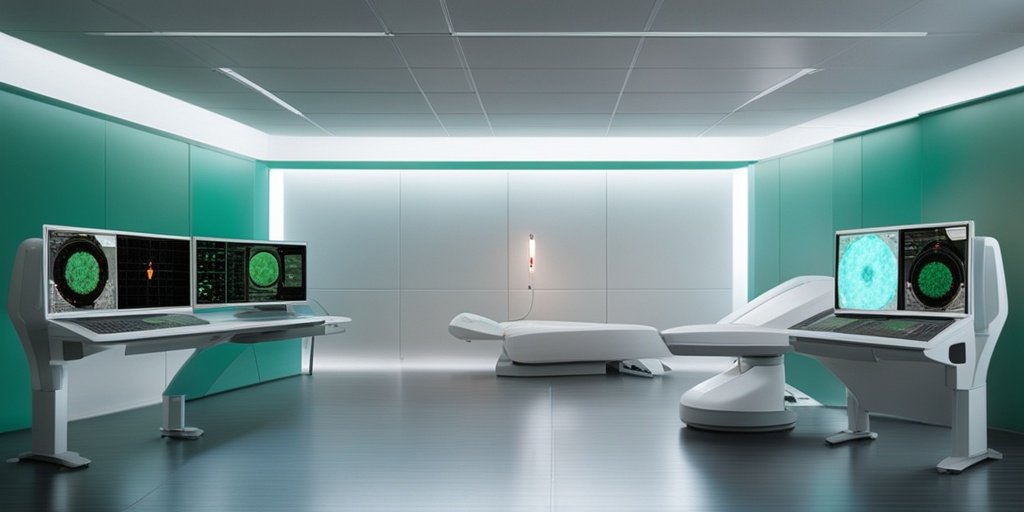⚡ Quick Summary
This study explores the use of delta-radiomics combined with machine learning classifiers to predict disease progression in patients undergoing magnetic resonance-guided radiotherapy for adrenal metastases. The findings indicate that incorporating auxiliary data sets significantly enhances prediction performance, with notable improvements in the area under the curve (AUC) metrics.
🔍 Key Details
- 📊 Dataset: 108 patients (90 internal; 18 external)
- 🧩 Patient demographics: 42 adrenal cancer, 23 lung cancer, 25 pancreatic cancer
- ⚙️ Technology: Decision tree classifiers with and without auxiliary data sets
- 🏆 Performance metrics: AUC-ROC values ranging from 0.43 to 0.70
🔑 Key Takeaways
- 📊 Delta-radiomics can effectively analyze tumor volume changes to predict disease progression.
- 💡 Auxiliary data sets from lung and pancreatic cancer patients improved prediction accuracy.
- 🏆 The F5||F1 model achieved an AUC-ROC of 0.70 with lung data, indicating strong predictive capability.
- 🤖 Decision trees provided an explainable model for external validation.
- 🌍 This research may pave the way for biologically adapted radiotherapy that recognizes radiomics signals for potential recurrence.
- 🗓️ Study conducted with a median dose of 50 Gy delivered over five fractions.
- 🔬 Clinical implications suggest enhanced monitoring and treatment strategies for patients with adrenal metastases.

📚 Background
The field of adaptive radiotherapy is evolving, focusing on the need to account for anatomical changes that occur between treatment fractions. As tumors can change in size and shape, understanding these dynamics is crucial for improving patient outcomes. The integration of machine learning with radiomics offers a promising avenue for enhancing predictive capabilities in cancer treatment.
🗒️ Study
This study analyzed data from 108 patients who received ablative radiotherapy, focusing on the changes in gross tumor volumes identified during daily scans. The researchers aimed to determine whether delta-radiomics could be utilized to predict disease progression events, specifically looking at the impact of auxiliary data sets on prediction performance.
📈 Results
The results demonstrated that the inclusion of auxiliary data sets significantly improved the predictive performance of the models. For the F1||F5 model, the AUC-ROC increased from 0.53 ± 0.12 to 0.61 ± 0.11 with lung data, and from 0.60 ± 0.14 with pancreatic data. The F5/F1 model showed similar trends, with AUC-ROC values reaching 0.65 ± 0.11 when lung data was included.
🌍 Impact and Implications
The implications of this research are significant for the future of cancer treatment. By leveraging delta-radiomics and machine learning, clinicians may be able to predict disease progression more accurately, leading to timely interventions. This approach could enhance the personalization of treatment plans, ultimately improving patient outcomes and quality of life.
🔮 Conclusion
This study highlights the potential of delta-radiomics in predicting disease progression during radiotherapy. The integration of auxiliary data sets has proven to be a valuable strategy for enhancing predictive accuracy. As we move forward, further research in this area could lead to more effective and tailored treatment options for patients with adrenal metastases and beyond.
💬 Your comments
What are your thoughts on the use of delta-radiomics in cancer treatment? We would love to hear your insights! 💬 Share your comments below or connect with us on social media:
Delta-Radiomics Using Machine Learning Classifiers With Auxiliary Data Sets to Predict Disease Progression During Magnetic Resonance-Guided Radiotherapy in Adrenal Metastases.
Abstract
PURPOSE: Adaptive radiotherapy accounts for interfractional anatomic changes. We hypothesize that changes in the gross tumor volumes identified during daily scans could be analyzed using delta-radiomics to predict disease progression events. We evaluated whether an auxiliary data set could improve prediction performance.
MATERIALS AND METHODS: We analyzed 108 patients (n = 90 internal; n = 18 external) who received ablative radiotherapy. The internal data set included 42 patients with adrenal cancer, 23 patients with lung cancer, and 25 patients with pancreatic cancer, with the clinical end point of progression-free survival events. The median dose was 50 Gy, which was delivered over five fractions. The delta features are the ratio of the features of the last to first treatment fraction, F5/F1, and the concatenation of the first and last fraction features, F1||F5. Decision tree classifier with and without auxiliary data sets, and the external data set was used exclusively for independent testing of the final models.
RESULTS: During internal training, for the F1||F5 model, the inclusion of the lung data set increased our AUC receiver operator characteristic curve (ROC) from 0.53 ± 0.12 to 0.61 ± 0.11, whereas the pancreatic data set increased our AUC-ROC to 0.60 ± 0.14. For the F5/F1 model, the inclusion of the lung auxiliary data increased our AUC-ROC from 0.52 ± 0.13 to 0.65 ± 0.11, whereas it modestly changed by 0.62 ± 0.13 with the pancreas. During external testing, for the F5/F1 model, we reported an AUC-ROC of 0.60 with the lung auxiliary data and 0.43 with the pancreatic data. Also, for the F5||F1 model, we reported an AUC-ROC of 0.70 with the lung auxiliary and 0.60 with the pancreatic data.
CONCLUSION: Decision trees provided an explainable model on the external data set. The validation of our model on an external data set may be the first step to biologically adapted radiotherapy recognizing radiomics signals for potential recurrence.
Author: [‘Fajemisin JA’, ‘Bryant JM’, ‘Saghand PG’, ‘Mills MN’, ‘Latifi K’, ‘Moros EG’, ‘Feygelman V’, ‘Frakes JM’, ‘Hoffe SE’, ‘Mittauer KE’, ‘Kutuk T’, ‘Kotecha R’, ‘El Naqa I’, ‘Rosenberg SA’]
Journal: JCO Clin Cancer Inform
Citation: Fajemisin JA, et al. Delta-Radiomics Using Machine Learning Classifiers With Auxiliary Data Sets to Predict Disease Progression During Magnetic Resonance-Guided Radiotherapy in Adrenal Metastases. Delta-Radiomics Using Machine Learning Classifiers With Auxiliary Data Sets to Predict Disease Progression During Magnetic Resonance-Guided Radiotherapy in Adrenal Metastases. 2025; 9:e2400002. doi: 10.1200/CCI.24.00002